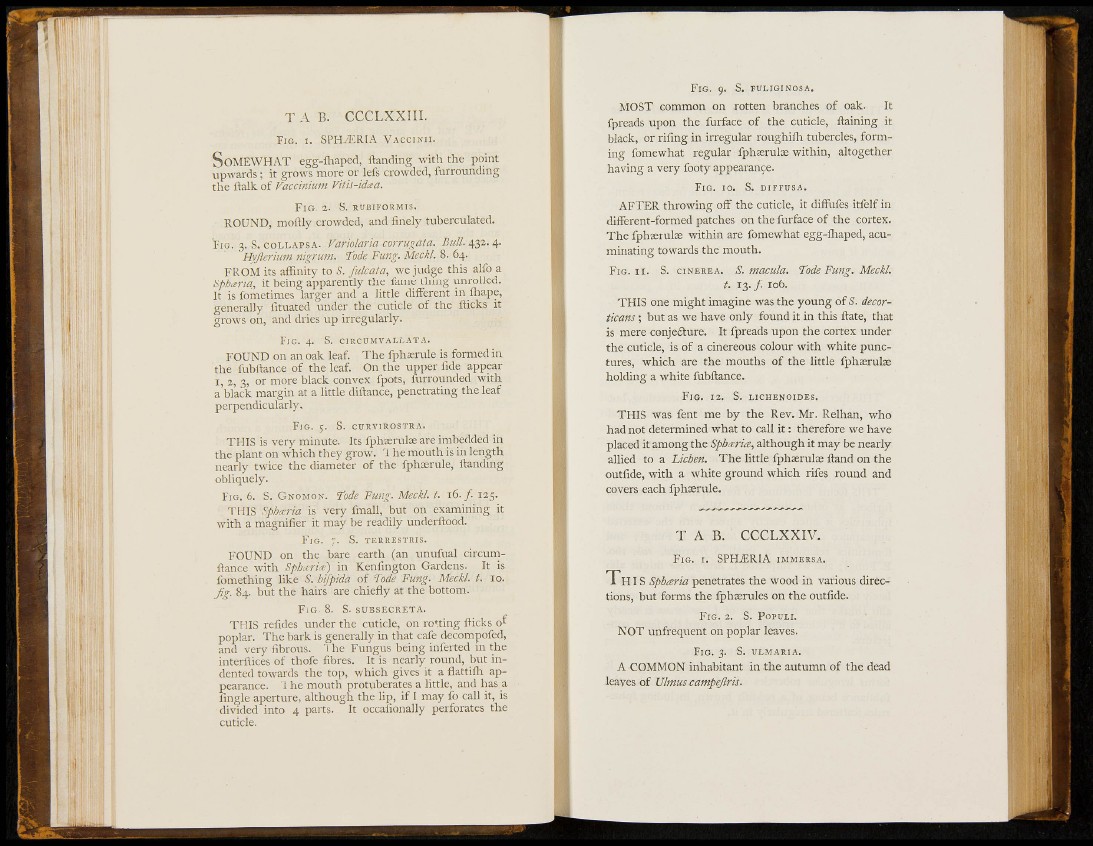
T A B. CCCLXXIII.
FIG. i. SPHIERIA VACCINII.
SOMEWHAT egg-fliaped, ftancUng witli the point
up^¥ards; it grows more or lefs crowded, furrounding
the ftalk of Vaccinium Viiis-idxa.
F I G . 2. S. EUBiroHMis.
ROUND, moftly crowded, and finely tuberculated.
FIG. 3. S. COLLAPSA. Varklaria corru^ata. Bull 432. 4-
' WJlerium nigrum. Tode Fung. Meckl. 8. 64.
F R O M its affinity to S. Julcata, we judge this alfo a
Spbaria, it being apparently the fame thing unrollea.
It is fometimes larger and a little different in fliape,
generally fitnated under the cuticle of the flicks it
grows on, and dries up irregularly.
FIG. 4. S. CIECOMVALR.ATA.
FOUND on an oak leaf. The fphierule is formed in
the fubftance of the leaf. On the upper fide appear
I, 2, 3, or more black convex fpots, furrounded with
a black margin at a little diftance, penetrating the leaf
perpendicularly.
FIG. S. CURVIROSTRA.
THIS is very minute. Its fphasruloe are imbedded in
the plant on which they grow. 1 he mouth is in length
nearly twice the diameter of the fphcerule, ftanding
obliquely.
FIG. 6. S. GNOMON. Tode Fung. Meckl. t. \6. f. 125.
THIS Sphxria is very fmall, but on examining it
with a magnifier it may be readily underftood.
F I G . 7. S. TERRESTEIS.
FOUND on the bare earth (an unufual circumftance
with Sphccria:) in Kenfington Gardens. It is
fomething like S.bijpida of Tode Fung. Meckl t. 10.
fg. 84. but the hairs are chiefly at the bottom.
F I G . 8. S. SUESECRETA.
THIS refides under the cuticle, on routing flicks of
poplar. The bark is generally in that cafe decompofed,
and very fibrous. 1 he Fungus being inferted in the
interilices of thofe fibres. It is nearly round, but indented
towards the top, which gives it a flattiflr appearance.
i he mouth protuberates a little, and has a
fingle aperture, altho ' ' '' r.
divided into 4 parts
cuticle.
lingle although the lip, if I may fo call it, is
• • — I t occafionally perforates the
FIG. 9. S. ruLiGiNosA.
MOST common on rotten branches of oak. It
fpreads upon the furface of the cuticle, flaining it
black, or rifing in irregular roughilli tubercles, forming
fomewhat regular fphserulae within, altogether
having a very footy appearance.
FIG. 10. S. DIFFUSA.
AFTER throwing off the cuticle, it diffufes itfelf in
different-formed patches on the furface of the cortex.
The fphserulce within are fomewhat egg-fliaped, acuminating
towards the mouth.
FIG. I I . S. ciNEREA. S. macula. Tode Fung. Meckl.
t. 13. / 106.
THIS one might imagine was the young of S. decorticans;
but as we have only found it in this flate, that
is mere conjeiture. It fpreads upon the cortex under
the cuticle, is of a cinereous colour with white punctures,
which are the mouths of the little fphserul®
holding a white fubftance.
F I G . 12. S. LICHENOIDES.
THIS was fent me by the Rev. Mr. Relhan, who
had not determined what to call it: therefore we have
placed it among the Sphicria, although it may be nearly
allied to a Lichen. The little fpha:ruliE fland on the
outfide, with a white ground which rifes round and
covers each fphasrule.
T A B . CCCLXXIV.
F I G . I. SPHiJRIA IMMERSA.
T H IS Spharia penetrates the wood in various directions,
but forms the fphaerules on the outfide.
FIG. 2. S. PopuLi.
NOT unfrequent on poplar leaves.
FIG. 3. S. ULMARIA.
A COMMON inhabitant in the autumn of the dead
leaves of Ulmus campejlris.